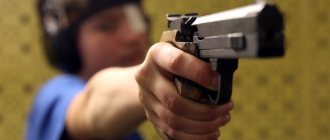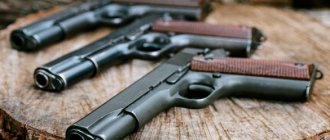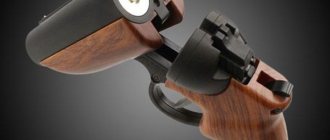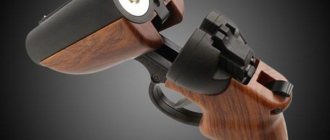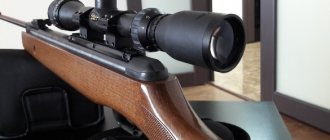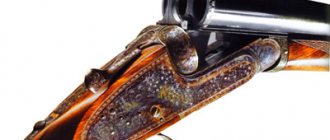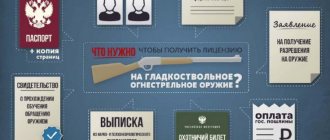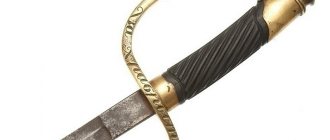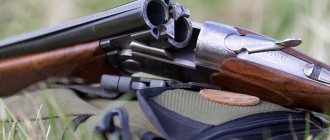Over time, each person has developed one or another idea about weapons, and if for some weapons carry a hidden threat, for others it is a way to ensure their own safety. In addition to hunting and self-defense, weapons are used in sporting events.
Usually, articles on such topics do not focus due attention; meanwhile, the law strictly defines the procedure for using sports weapons, and also establishes the need and opportunity to buy them or obtain permission to store them.
Sporting weapons are not intended to hit a living target, but they have sufficient destructive power that certain requirements are imposed on the owner. Let's consider the opportunity that is provided to citizens to obtain the appropriate permit for sporting weapons.
Classification of sporting weapons
Almost any sporting weapon is defined by law as a civilian weapon. The only exceptions are short-barreled pistols. Even from the name of the category itself, it becomes clear that weapons are used as equipment when engaging in certain sports. In the most trivial classification, sports weapons are divided into several types.
- Steel arms. It includes piercing and cutting weapons that have certain technical parameters.
- Throwing weapon. It is intended to hit a target at a distance.
- Pneumatic weapons with a caliber exceeding 4.5 mm. Note that a caliber of up to 4.5 mm allows pneumatics to be classified in a different category.
- Firearm with a rifled barrel. Here we mean both a long-barreled gun and a short-barreled gun, which every amateur dreams of purchasing.
- Smoothbore firearms.
Of all the listed types, only short-barreled rifled weapons require licensing. Melee weapons are permitted if you have a hunting license; throwing weapons do not require a license. Pneumatics with a caliber above 4.5 mm have a muzzle energy of up to 3 J, which transfers it from the category of weapons to the category of weapon-like structures. Small-caliber weapons do not need to be licensed, although such a category is not defined in the weapons law.
Weapon care
Frequent shooting at the range can negatively affect the condition of the weapon. If a light gun is loaded with reinforced or even medium charges, it will quickly become loose in the place where the barrels are attached to the block. Weapons for sport shooting are made from high-quality metal. High-quality assembly and fitting of parts will give a good service life even under heavy load. If you keep the weapon in order, clean and lubricate it, and also correct the slightest problems in the mechanism in a timely manner, the gun will last a long time.
Who can get a sporting weapons permit?
Even without delving into theory, we can answer that the right to purchase or store sports weapons is vested in persons officially involved in sports. Moreover, these citizens are engaged in those sports that involve the use of weapons, that is, not every athlete will be able to purchase a sports short-barreled weapon.
Citizens who have a special athlete’s passport will be able to buy long-barreled firearms. There is also an alternative document confirming participation in a sport involving the use of weapons, this is a document on the assignment of qualifications.
Sporting pistols with a rifled barrel are only available to highly skilled athletes. Naturally, they must document their qualifications.
Long-barreled smooth-bore sporting weapons are included in the same category as hunting weapons, so this type can be purchased by a citizen who has presented a hunting license and received prior permission to purchase. But to obtain the right to buy a rifle, that is, a long gun with a rifled barrel, even athletes must own a smoothbore gun for five years.
Pneumatics with a shot energy of up to 7.5 J are not subject to licensing, but their caliber should not exceed 4.5 mm. Large-caliber pneumatics are allowed to be purchased by citizens at the request of the sports federation. Despite all the variety of rules and requirements, the registration of a license takes place according to the same streamlined algorithmic scenario.
Hunting with a sporting rifle
Photo by Anton Zhuravkov
I’ve heard from some advanced hunters: “I wish I could get a gun for shooting on a trench stand, model “MC” TsKIB SOO! These guns are extremely reliable, have a precise and sharp action and are ideally suited for hunting.”
To be honest! I also could not escape the temptation to hunt with such a gun. The length of the block barrels for the MTs 8 trench stand was 750 mm, the choke constrictions: the lower barrel was 1.0 mm, the upper barrel was 1.2 mm. First of all, using a bench cartridge with shot No. 7, a shot load of 32 g, I checked for accuracy at 35 m. The lower barrel showed 70%, and the upper 77%. At that time, cartridges were loaded into folder cartridges, with felt wads and shot loads up to 36 g.
Once the Council of the All-Russian Public Educational Organization of the Moscow Region rewarded me with vouchers to open a summer duck hunt at the Zabolotskoye hunting area. We shot with bench cartridges with shot No. 7, we shot fun, easily and accurately. A rare teal broke through our “chain”. The head of the hunting farm reported to the Council that we had exceeded the shooting norm and with our “sharp” shooting ruined the holiday for veterans of the Great Patriotic War, and asked the teams of clay pigeon shooters not to send them to him.
I can say: with a cartridge with shot No. 7, ducks and black grouse were cleanly hit at a distance of up to 40 m. Sometimes at a distance of up to 30 m (if hit by the center of the scree), one had to be content with an almost plucked bird, unfit for consumption. There were also frequent mistakes. And the confidence in a reliable fight was relaxing, and I often shot at 45 meters or more. With a successful shot, a grueling search began - there was no dog.
In late autumn, in the Sknyatinsky hunting estate, cartridges with shot No. 5 reliably hit ducks on the fly and with stuffed animals at a distance of 45–50 m. When shooting with shot No. 3, the accuracy decreased, and with cartridges with shot No. 1 or 0, the superiority over my IZH-12 gun disappeared. I went out to hunt wild boar and elk several times, and I never managed to put the animal down. The animal went far away if someone from the next room did not get it.
Once during a training session he complained to Oleg Losev, an unsurpassed authority not only in skeet shooting, but also as a hunter, that he was having trouble shooting with a bullet while hunting. He advised: “You have a circle block, so shoot with a bullet.” Having made targets, during one of the training sessions I tested both blocks with a Brenneke bullet by shooting at a distance of 50 m. The results are as follows: the dispersion diameter of the trench block from the lower barrel is 35 cm, the upper one is 43.
The holes were not entirely round. The barrels “chewed” the bullets. But the block of “bells” trunks gave a dispersion diameter of 9–12 cm. The test gave me confidence in the “bells,” and I hunted ungulates only with this block. Some of my “trencher” comrades, hunting with a sporting rifle, had problems with the butt due to its length while hunting in late autumn or winter. Customizing a stock is more expensive for yourself and will affect your results in sports shooting. It was easier for me. The stock was adjusted for shooting on a round stand.
To better clarify the situation with the use of a shotgun while hunting, I will cite statements on this issue by the most famous athletes of the Fatherland. Evgeny Petrov, Olympic champion, Honored Master of Sports: “Back in 1960, they gave me a gun... Nashenskoe, by the way, is the Tula MC... This Tulka served well somewhere in the garrison, and never let me down. In my house, in a place of honor, hangs this gun with the memorable number 8384. I’m a veteran and now sometimes I take it hunting or to the shooting range to play around with.”
S. Losev, European champion, master of sports, multiple winner at various recent competitions of the Moscow garrison: “Hunting with a shotgun? Well, if there is no other way, then why not? But I would like to see a hunter with a trench shotgun hunting snipe.”
V. Korzinkin, Master of Sports, Senior Instructor in Skeet Shooting of the Central Council of the All-Russian Educational Organization: “Personally, I hunt with a semi-automatic Beretta... for geese. Some hunters buy skeet guns for hunting. If you decide to purchase a sports gun, then you should buy it with two pairs of barrels - both for the “trench” and for the “circle”. I think it's clear why.
With a gun for shooting exercises “ladder”, in late autumn and winter in a warm jacket it is very difficult to throw the gun to your shoulder without the butt catching your clothes. We have to correct the production. The time for the right shot has passed. The hunter at the subconscious level begins to control himself, gets distracted, and a mistake is inevitable. And MC guns are the dream of every hunter.”
From the above, the following conclusions suggest themselves:
1. One of the main advantages of the MC model gun is its survivability. According to E. Petrov, he shot more than 500 thousand rounds of ammunition from his tulka. The same resource was shot from MC 8 by the famous athlete, repeated champion of many union and international competitions N. Durnev. At least half a million were shot with the MTs 11 shotgun by V. Gerasina, the world and European champion. S. Demina, a multiple world and European champion, crossed the half-million mark with the MTs 108 gun. Agree, it is rare that any hunter will be able to shoot at least a noticeable portion of this number of cartridges in his hunting life. Shots of 500 thousand from TsKIB SOO sporting shotguns are a real fact. Such a gun will serve more than one generation of hunters in the family. For this reason alone, it is worth purchasing.
2. I consider the barrel length 660–675 mm to be positive about the MC model shotgun for a round stand. When fired, these barrels give a wide and uniform scree, which makes it easier to shoot at swamp-meadow, field and upland game (woodcock on draft too) in the forest and bushes at short distances (15–25 m), and using cartridges with container wads will ensure defeat of game birds at distances of 35 m. There is no doubt that the MC shotgun for a round stand with shortened barrels and a butt is more maneuverable and posadistic.
3. A hunter who has bought a gun for shooting the “ladder” exercise must remember that the design of this gun was initially designed to “raise” the target, since the targets rise, the stock of such a gun is straighter and longer. In such a gun you will have to adjust the stock to your physical characteristics. It is better to entrust this work to a master. For trench rifles, hunters have to reduce the length of the stock, remove the comb, and increase the pitch. Wooden parts for a trench gun allow this kind of work to be done.
4. Some hunters regret that shotguns have a chamber length of only 70 mm and cannot be fired with magnum cartridges. There is no need to be upset about this. Modern shotguns with 76mm and 89mm chambers are not exactly magnum shotguns. Gunsmiths make such chambers in order to be able to place 32–56 g of steel shot in a long cartridge case. A magnum shotgun, as a rule, has a mass of 5–6 kg (for example, a 10-gauge Browning Gold shotgun, with a barrel length of 122–132 cm, a chamber length of 89 mm, and a weight of 4.73–4.9 kg. If there is a need to shoot more powerful cartridges from a gun with a 70 mm chamber, then companies equip the cartridges in a 70 mm case with a shot load of up to 56 g, developing a firing pressure of up to 1050 bar. Model MC TsKIB SOO bench guns can handle such cartridges easily.
Summer hunting is opening soon. For catching small and medium-sized birds, bench cartridges with a 24–28 g shot load with numbers 7 or 9 are quite suitable. Believe me, many years of experience, this is what you need. A factory-made cartridge today turns out to be cheaper than a “roll-your-own” cartridge equipped with purchased components. And there is no need to bother with their equipment. Another thing is that during the late autumn migration of waterfowl, when hunting hare and fox, you will need cartridges with the specified accuracy and sharpness of combat. They can only be achieved by independently equipping cartridges. And this is another song.
5. If possible, then you should not refuse to purchase a gun of the MC model, especially one equipped with two pairs of barrel blocks. Hunters who are not short of money can order their favorite gun directly from TsKIB SOO, taking into account their physical characteristics, with two blocks of barrels: the first - with a barrel length of 750 mm with the required chamber length and constant choke constrictions of 0.5–1.0 mm, the second - with a barrel length of 660–675 mm, and a chamber length of 70 mm, the choke constrictions are a cylinder without bells.
Victor Radov July 18, 2014 at 00:00
Who cannot get a sports permit
Before applying for a permit, you must ensure that you meet the basic applicant requirements. If at least one requirement is not met, then you will most likely receive a denial of your application. These requirements are presented in the list.
- There is a limitation on the age of the applicant. At least it concerns the minimum age. Only citizens over 18 years of age can purchase sporting weapons.
- Medical examination data is fully taken into account when considering the application. Thus, citizens who are registered with a narcologist or psychiatrist, such as drug addicts, alcoholics, and gambling addicts, will not be able to receive the treasured document. Vision indicators are also important.
- In the process of considering the application, the OLRR sends a request to the Internal Affairs Directorate regarding the applicant’s criminal record. If it is discovered that a citizen has been or has been brought to criminal liability or has an outstanding criminal record, then the permit will be refused.
- If documents confirming the high qualifications of the athlete are not submitted, and if there is no hunting license when submitting an application for the purchase of a long-barreled hunting rifle, the application will be rejected.
- They will refuse to issue permits to citizens who are not registered anywhere.
- If a citizen has been held accountable for violating a law related to public order in the last year, the permit will also be denied.
Brief algorithm for obtaining permission
This question does not cause any difficulties, since the pattern of citizens’ actions is quite simple. If the applicant meets all the listed requirements, then he can safely begin the procedure for processing documents.
At the first stage, you need to come to the OLRR to hand over the collected package of documents, as well as write an application. The time frames allocated for the review of documents have been determined, but they are rarely adhered to, since departments are overloaded with work. On average, it takes about a month to obtain a license. As a result of submitting an application, the citizen will receive a refusal or a notification with the date of his next appearance at the department.
With the permit in hand, you can choose a suitable weapon for yourself; this permit is valid only for the first 6 months. After purchasing a barrel, it must be brought to the department and registered. You cannot store weapons without a special license, so after registration you must obtain another permit to carry and store.
List of required documents
In order to reduce the time of the licensing procedure, the necessary documents should be prepared.
- Certificate of passing a medical examination. We take it at a clinic or any suitable medical institution where medical examinations are carried out. Certificate form – 002-О/у. In addition to this certificate, it is necessary to undergo examination by a narcologist and a psychiatrist. To be more precise, you should take statements stating that you are not registered at dispensaries. In addition, urine is submitted for chemical analysis. Starting in 2022, this analysis has become mandatory.
- Passport. No one will force you to leave the original document, but you will have to provide photocopies. You should make copies of the first page, as well as the one on which there is a stamp with a valid registration.
- Two photos. A photo of the required format will be taken for you in any studio. Format – 3x4 cm. The photograph must be black and white and printed on matte paper. The photo is taken from the front, with a light background. Headwear is not allowed.
- Hunting ticket. When registering a hunting weapon, you will need a hunting license. If there is none, then the easiest way is to apply for it through the MFC. The service is free, and registration will take only 5 working days.
- Confirmation of qualifications. A document indicating the athlete's qualifications. We do not indicate exactly what documents these are, since they are different in different sports federations.
- Sports passport.
- Training documents. Certificate indicating that you have completed firearms safety training courses. A certificate confirming successful completion of the course and passing the relevant exams.
As we had to see, in terms of documentation, obtaining a permit for sporting weapons is not so difficult. But in practice, everything depends on the availability of documents for athletes, that is, not every citizen, even with all the desire, will be able to obtain the right to purchase sports weapons.
As part of import substitution
For objective reasons, the production of domestic sporting small arms after 1991, to put it mildly, experienced a decline. As a result, Russian shooting athletes were forced to use weapons almost exclusively of foreign manufacture. By 2014, when the West initiated anti-Russian sanctions, this had become not even a habit, but a tradition.
Even before 2014, Russian sports schools and shooting clubs experienced difficulties in obtaining sporting firearms, since there were no domestic ones, and foreign ones, taking into account the foreign spare parts and accessories, were very expensive. After the introduction of anti-Russian sanctions, these difficulties increased manifold.
Russia had to think about import substitution. As part of this policy, a program has been launched to revive the Russian production of sporting small arms and ammunition. The Russian government, the Ministry of Sports, defense industry enterprises, and most importantly, private enthusiasts joined in the implementation of the program. It was thanks to the latter that the Russian experimental and implementation enterprise “Russian Weapon Systems and Technologies” (ROST) arose, which undertook the creation of modern Russian sports pistols of the “Soratnik” family.
Borrowing successful design discoveries and refining already proven schemes have long become an integral part of creating any workable product. It is not surprising that a successful weapon design can last a very long time - take the Kalashnikov assault rifle, for example. The design, adopted by the Soviet Army back in the late 1940s, continues to serve safely around the world in the form of countless clones and updated designs based on previous ones, which, of course, were created on the basis of... Well, you get the idea.
Federal News Agency / Andrey Soyustov
The history of the CZ 75 pistol is somewhat similar to this machine gun odyssey. Developed in 1975 in Czechoslovakia, the 9 mm CZ 75 had an extremely successful design and excellent ergonomics. But even these excellent performance characteristics did not suit sports shooters, so a special sports version of the “seventy-five” was developed for them - the CZ 75 SP-01 Shadow.
The new pistol seemed to be specially created for a new shooting discipline - practical shooting. As its popularity rapidly grew, so did the demand for the CZ 75 SP-01 Shadow. In Russia, which also did not escape the “epidemic” of practical shooting, the pistol received the nickname “Chizhik”. Outside the Czech Republic, the Swiss and Italians created their own sports pistols on the CZ 75 platform under the names Sphinx and Tanfoglio.
What does all this have to do with our history? The most direct! In order to save effort and money, ROST employees decided not to reinvent the wheel, but to use time-tested designs as the basis for their pistols.
The public saw the first results of their work at the Arms & Hunting 2016 exhibition, where mock-ups of two sports pistols appeared under the Soratnik brand - 9 mm SP-9 and 5.6 mm SP-15. The basis for the SP-9 was the platform of the Chizhik, already known to us. SP-15 was created on the basis of the best domestic sports pistol for bullet shooting IZH-HR-30, developed by outstanding Soviet designers Vladimir Razorenov and Efim Khaidurov , but long since discontinued.
Representatives of ROST reported that the launch of new sports pistols into series is possible from mid-2022. At the same time, the production of “Companions” was to be completely localized in Russia.
But, as they say, it was smooth on paper... The journey of “Companions” from demonstrating mock-ups to launching already firing pistols into production took much longer than initially expected. This was caused not so much by the need for technical improvements to the pistols, but by the protracted overcoming of stop factors in the area of the existing “standards”.
